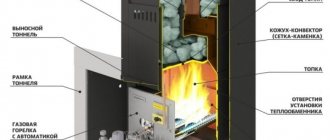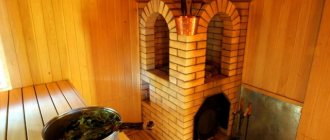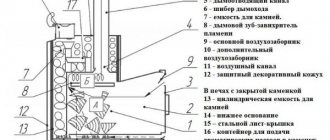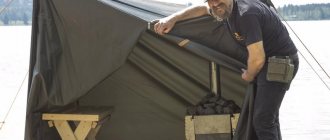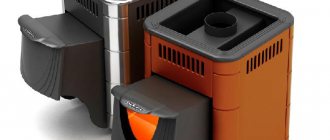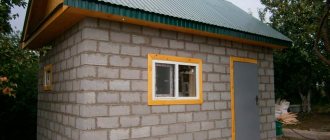The problems of choosing sauna stoves are associated with the variety of priorities put forward by future users, as well as with the fact that information about the real performance of certain stoves, if it exists, is in fragmentary form. There are attempts to compare models of some manufacturers with models of others, but everything again comes down to criteria, to the fact that there is no universal stove that would suit everyone without exception.
Design Features
A wood stove is a basic type of solid fuel structure. It has been used for several millennia and does not lose its position due to its simplicity, high efficiency and ability to work independently, without the use of electricity.
The design of a wood-burning stove is a combustion chamber with openings for removing combustion products (chimney) and for supplying fresh air (blower).
Main components and structural elements:
- combustion chamber;
- ash pan;
- heater;
- chimney.
Combustion chamber and ash pan
These are two adjacent elements located above each other (ash pan at the bottom). Fuel is burned in the firebox, and the ash pan serves as a collection point for ash and at the same time provides fresh air access to the firebox.
Kamenka
This is the main feature of sauna stoves. It is a container filled with large pebbles or fragments of hard rocks. Used as a heat accumulator, allowing you to quickly evaporate water and change the conditions in the steam room.
The chimney serves to remove combustion products. The level of traction and the ability to ensure safety for users depend on the height and cross-section of the pipe.
In addition to the main components, the design of a wood-burning sauna stove often includes a tank for heating water . This design significantly expands the functionality of the oven. At the same time, its cost and fuel consumption increase slightly.
Heating area
A wood stove is not the best way to heat large spaces.
This point must be taken into account when choosing a suitable design for a bathhouse measuring 60 m2 or more. Sometimes in a large room it is necessary to ensure the desired temperature and at the same time maintain the style of a Russian bath.
It is recommended to use a wood stove for local heating, and choose another, more powerful system as the main heat source.
The best Russian boilers for wood-fired saunas with a tank
Russian models of wood-burning boilers are recognized throughout the world as high-quality and reliable equipment without any frills and excessive automation of combustion processes.
Taman 10 TB
One of the best domestic models, which, when designing the product, paid great attention to the issue of the temperature of the exhaust flue gases, reducing it to a minimum and thereby ensuring a comfortable atmosphere in the steam room.
Taman 10 TB
Specifications:
- Dimensions – 702x331x850mm.
- Weight – 46 kg.
- Material – structural steel.
- Type of heater: open.
- Chimney diameter – 115 mm.
- The volume of the steam room is up to 10 cubic meters.
The main advantage of the model is that the firebox walls are made of structural steel up to 4 mm thick, which ensures a long service life of the product. It is also worth noting the low cost of the device - on average, the purchase will cost 12,000 rubles.
Operating instructions Taman 10 TB
Ermak 12
Compact model for arranging a small bathhouse with a steam room volume of up to 14 square meters. meters. The firebox is made of steel 6 mm thick. The body and flue system are made of steel 4 mm thick, in places with the greatest thermal load - lined steel up to 6 mm.
Ermak 12
Design Features:
- Firebox depth – up to 500 mm.
- The location of the chimney is central.
- Power – 12 kW.
The average cost of such a stove is 11,900 rubles.
Operating instructions for Ermak 12
Varvara Polenitsa
A stove for a bath from a Tver manufacturer, which offers its customers economical and easy-to-use designs. A convenient option for a bathhouse that is not connected to a water supply. The water tank is hung in a special pocket on the side wall of the stove; heating is carried out by heat transfer from the wall of the structure. The main advantage is that the tank is removable, it is easy to remove and wash.
Varvara Polenitsa
Technical characteristics of the device:
- Power – 18 kW.
- Combustion chamber capacity – 0.075 cubic meters.
- Fuel - firewood.
- Dimensions – 860x450x720 mm.
- Weight – 120 kg.
- The internal volume of the chimney is 110mm.
- The volume of the steam room is 24 cubic meters. meters.
- The capacity of the mounted tank is 50 liters.
Among the advantages of this model, it is worth highlighting such points as ease of installation and maintenance, there is no need for a water supply system, the water tank is made of food-grade steel, fast heating of water, uniform heating of the stones.
And, of course, we should not forget about this main advantage - it is affordable - the average price of the product will be 18,000 rubles.
Advantages and disadvantages
The advantages of wood stoves include:
- the presence of a “live” fire creates a specific atmosphere and gives bathing procedures a special charm;
- high heating rate and ease of adjustment of the combustion mode;
- the ability to use different types of fuel, traditional firewood or their modern modifications (coal, briquettes, pallets, etc.);
- the ability to operate autonomously without connecting to electricity;
- ecological purity of fuel;
- relatively low cost;
The disadvantages of wood stoves are considered to be:
- the combustion process causes the formation of carbon monoxide, which is dangerous to human health and even life;
- the need to assemble a high-quality chimney of the correct size, without cracks or holes;
- wood stoves are fire hazardous and require compliance with the rules of use;
- the efficiency of the stove depends on the quality and condition of the fuel - it is not easy to heat a room with raw wood;
- if a stationary brick kiln is being built, the entire range of work will have to be completed, starting with the foundation.
The pros and cons of wood stoves are well known to all users, so they are usually considered as design features.
How dangerous are wood stoves?
The danger of wood-burning stoves lies in the presence of carbon monoxide and the possibility of fire in the bathhouse. Carbon monoxide can fill a room and pose a threat to people's lives. At the same time, it is not detected by the senses in any way - it has no color or smell, which makes it very dangerous.
The most effective way of protection is to install a high-quality chimney with a stable draft, and choose the right time to close the views. The dangers of carbon monoxide have been described many times and are well known, but the number of cases of poisoning remains too high.
The possibility of fire is a typical drawback of all heating devices, especially if they use combustion. It is necessary to comply with fire safety measures, having first carefully studied the requirements and followed all instructions.
However, the dangers of wood stoves should not be exaggerated. Statistically, they are less likely to cause trouble than gas or electric structures. If you take operation seriously and carefully, no problems will arise.
How to choose stones for a bath
Experts advise choosing stones of volcanic origin. They are resistant to high temperatures, damage and cracking. The best option for heaters would be stones of various sizes, rounded in shape and smooth surface. Large cobblestones are used as the basis of the masonry, moderate-sized stones are placed in the middle part, and the smallest ones are placed at the top. Of the stones used in sauna stoves, the most popular are granite and basalt, quartz and andesite, as well as ordinary pebbles. They can be purchased at the store or assembled yourself. For better heat retention, you can use fire-resistant ceramics or porcelain along with stones.
Varieties
There are many design options for wood-burning sauna stoves.
They can be divided into two categories:
Metal
Brick
As a rule, metal stoves are purchased or made to order and installed in the room ready-made. They are compact and rarely need their own foundation.
However, such designs belong to the category of continuous burning stoves - they must be heated all the time while the bath procedures last, otherwise the temperature in the room will quickly drop. At the same time, heating of the room occurs much faster than with brick structures. This allows you to save fuel (if you don't steam for too long).
Metal furnaces are divided into two groups:
Steel
Cast iron
Cast iron stoves are more expensive. They have thick walls that can accumulate heat, so they cool down more slowly. While a steel stove can be made at home, a cast iron structure requires special conditions, equipment and technology.
Therefore, in terms of technical characteristics, cast iron models are preferable to steel ones. However, they also have some disadvantages - high cost and heavy weight. Larger models may even require their own foundation.
Brick stoves are built directly inside the bathhouse, which requires a whole range of construction work. They require their own foundation, not connected to the supporting structure of the bathhouse. In addition, the construction of the stove must be carried out by an experienced and qualified craftsman to eliminate the risk of carbon monoxide and ensure stable draft.
Brick stoves are able to accumulate thermal energy, which allows them to maintain the temperature in the room for some time after kindling. However, such a stove will take much longer to heat up. This affects fuel consumption, especially if the size of the stove is large enough.
Which stove to choose, metal or brick?
The choice of a suitable stove is determined by the capabilities of the room and the personal preferences of the bathhouse owner. If the area is small, it is better to install a small metal stove. However, for large rooms it is better to choose a brick stove that can heat for a long time without the need for a constant supply of firewood.
Laying a brick kiln can take about 3 weeks (taking into account the time for pouring the foundation and allowing it to harden). A metal stove can be purchased and installed in one day. This often becomes the main factor determining the owner’s choice.
Another factor, not the most important, but often considered first, is appearance.
Metal stoves are made in different design options, from antique styling to modern models in Hi-Tech or Art Nouveau style. The brick oven is traditional and conservative. It is built in a certain design and very rarely changes its appearance.
The best foreign boilers for wood-fired saunas with a tank
When choosing a boiler for a wood-fired sauna, you should also think about its safety. Domestic models are often energy independent; foreign products require an electrical connection
Harvia 20 ES Pro S
A budget option from a Finnish manufacturer, which is characterized by a long service life, high performance and convenient operation.
Harvia 20 ES Pro S
Model specifications:
- Dimensions – 430x760x650 mm
- Weight – 75 kg
- Thermal power – 18 kW
- Chimney diameter – 115 mm
- The volume of the built-in tank is 20 liters.
The outer casing of the unit is made of stainless steel, there is a cast iron door with glass to complement the special atmosphere of the sauna with the reflections of the fire.
The average cost of the stove will be 39,000 rubles.
Operating instructions Harvia 20 ES Pro S
HARVIA 36 DUO
The peculiarity of this model is that the body is made of stainless steel, resistant to corrosion, which is especially important when using the device in a sauna or bathhouse. The stove is installed in the steam room, but the fire is carried out from the adjacent room.
HARVIA 36 DUO
Specifications:
- Dimensions – 810x510x510 mm
- Weight without stones – 80 kg
- Thermal power – 31 kW
- Steam room volume – 14-36 cubic meters
- Chimney diameter – 115 mm
The average cost is 89,000 rubles.
Operating instructions HARVIA 36 DUO
Kastor Karhu 18 PK ES
A model with a built-in tank from a well-known Finnish manufacturer, which has been supplying high-quality stoves for baths and saunas to European markets for almost 100 years. Kastor Karhu 18 PK ES is made of stainless alloy metal and has a heat-resistant glass insert in the door.
Kastor Karhu 18 PK ES
Product Specifications:
- Dimensions – 435x695x780mm.
- Tank volume – 26 liters.
- Chimney diameter – 135 mm.
- The weight of the stove is 76 kg.
- The volume of the steam room is up to 18 cubic meters. meters.
The average cost of this model will be 49,000 rubles.
Operating instructions Kastor Karhu 18 PK ES
Frequently asked questions
Users choosing a wood-burning stove for a sauna often have the same questions. These can be answered in advance so that people don’t have to waste time thinking:
What is better, a stove with or without a water tank?
It is always recommended to prefer stoves with a water tank - they do not increase the cost too much and have virtually no effect on fuel consumption, but they provide a lot of additional options.
Do you need extra power for a wood stove?
Necessary and even necessary. The efficiency of a wood-burning stove is not infinite; in winter frosts, without a power reserve, you will have to warm up the bathhouse for too long, which means high fuel consumption. It is much easier to slightly reduce the supply of firewood, but be able to increase heat transfer.
Which model is better to choose, domestic or imported?
Most imported stoves are much more expensive than domestic ones. However, price should not be the main determining factor. First of all, we need to consider the technical characteristics, especially the firebox material.
What size water tank is best?
A large tank will require a long time to warm up the water. Therefore, it is customary to be guided by the following criteria - for one person you need to install a capacity of 50 liters, and for a company of several people - twice as much.
Which furnaces require a separate foundation?
According to SNiP, a separate foundation is required for stoves weighing over 700 kg. If the base for the bathhouse is a monolithic slab, a separate foundation for the stove is not required. It is necessary to take into account that for structures whose weight approaches the maximum, it is better to immediately build a separate support system.
When choosing a wood-burning stove, you need to take into account the size of the bathhouse, the size of the interior, the type of foundation and other features. There are domestic and imported models on sale. They differ little in performance indicators, except for the price - foreign analogues are more expensive.
In addition to the main qualities, you should consider the presence of additional functions (for example, a water tank), take into account the size of the heater and other features. This will help you choose the most successful model. If brick structures are preferred, you will have to allocate time to build and shrink the stove. At the same time, its ability to heat the room will be significantly higher than that of metal ready-made models.
Ratings
And since you, dear reader, have most likely already decided which group you belong to, let’s form a general opinion by speaking in our surveys about which stove you consider the best, based on your own experience (if your stove is not on the list — write the name in the comment, we will add it):
Best steel
From a pro's point of view
From a hobbyist's point of view
From the point of view of undemanding vapers:
The best cast iron
From a pro's point of view
From a hobbyist's point of view
From the point of view of undemanding vapers:
***
We hope that we were able to not only say the banality that a universally “best” oven simply does not exist in nature, but also suggested a method for independently calculating the one that will be optimal specifically for you. However, you can also focus on the results of surveys in each group.
